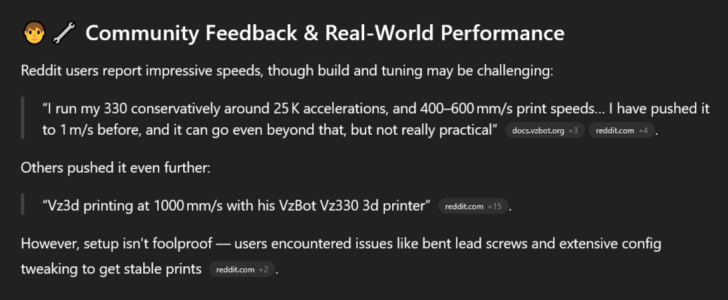vorondesignlover
Active member
Very interesting mod, but need to figure out if could be overkill. Based on the below table, ABS should be still good to print until PC (may be even CF-Nylon / CF-PC ??). I can't find any real usage for the last twos.The printed parts are PC (polycarbonate) blend with carbon fiber wich definitely is a significant upgrade in terms of strength and temperature resistance compared to standard PETG. also his quality is out of this world according to almost all of his clients.
High-Performance Materials (High-Temp Build Required)
| Material | Nozzle Temp | Bed Temp | Chamber | Key Properties | Use Cases |
|---|---|---|---|---|---|
| Nylon (PA6, PA12) | 250–280°C | 80–110°C | Yes (60–80°C) | Flexible, very tough, absorbs moisture | Gears, bushings, tooling |
| PC (Polycarbonate) | 270–310°C | 110–130°C | Yes (70–90°C) | Rigid, strong, heat resistant | Functional parts, brackets |
| CF-Nylon / CF-PC | 260–300°C | 100–120°C | Yes | Carbon-fiber filled = strong, stiff, abrasive | Robotics, end-use parts |
| PEI (Ultem™) | 360–400°C | 130–160°C | Industrial chamber | Flame-retardant, ultra-high strength | Aerospace, medical |
| PEEK / PPSU | 360–420°C | 130–160°C | Industrial chamber | Chemically and thermally resistant | Extreme engineering use |
Is this is the kit you're talking about? 200€ are a lot of money and I'm not sure about the return in benefits. If what I wrote above is true, then it will be mostly strenght, but even in such case I have doubts because users seem satisfied even with ABS. I also see that if one day I want to go IDEX, I'll have to buy the related kit again (the single toolhead version seems not upgradable).
Their AWD kit is very interesting and its price reasonable, but as soon as you select the full kit, price sky rocket. We're exiting from DIY world and entering more into the commercial world.
Very interesting! How you think would compare with a V-Core 4? The first difference I can think of is that this is going to be much more expensive. I'll understand the correct way to interpret performance data only once I'll have my first printer of my hands, but with a superficial read to me seems much slower than a v-core 4. The page you linked shows 12600 of acceleration with AWD (Bambulab X1C can reach 20000) while the V-core 4 500 reviewed in this video reached 800mm/s at 30000 (30k) acceleration with no issues in quality:To prove that this person knows what he is talking about, here is his own build log of a machine that he designed out of other machines good ideas:

V-Core 4 is not even AWD and I'm very curious to see how would perform with it. During researches I was thinking on how to implement AWD in a Voron, but I feel like it will be probably useless in a v-core 4 given how it performs without.
I suppose the guy has done this just for fun, I hardly doubt a printer like that can have success in the market.
I had chances to know about its existence when I was looking at the mods for the Voron. I've been tempted for a while, but then I returned back immediately to Voron: when printers are so small, even 20mm of printable space can be precious. Even the attraction to its performance quickly fade: since I was going to build a Voron from scratch I just thought I could make it fast as it.but I am now finding my next machine I think, through searching these parts and links for you I come accross this,

Mellow echte diy vzbot awd 330 vz330 3d drucker kit für hochwertige cnc metall leichte hoch geschwindigkeit druck mit klipper - AliExpress 7
Smarter Shopping, Better Living! Aliexpress.comnl.aliexpress.com
That is a beast! I would only investigate if the hextrudert could be changed for the same with 60:10???

400-600mm/s at 25k is still much slower than a v-core 4 500mm.
1000 mm/s seems problematic in every printer, but in hybrid--corexy step-loss occurs at 34000. To me seems a very good result. Whether 1000 mm/s is achiievable with the right optimizations and mods I have no idea.
The guy said that even 800mm/s at 58000mm/s could be achievable if he can manage to solve the outliers:
Also please note that, unlike v-core 4, VzBot run in AWD and 48V. With these mods implemented in a v-core I expect even more gap between the twos. I also see that a VzBot kit is more expensive than a v-core 4.
I would never go with a VzBot, but may be you found other valid reasons I'm not aware of.
My main concern when I opened this thread was about the performance loss when trying to scale a CoreXY beyond 350 mm. Based on the new info I had chance to discover while posting, I have to believe that, if the big printer is well designed, the loss is minimal. I've been surprised to see a 500mm printer going faster than a 330mm one extremely optimized for high performance. Unless someone know other aspects I'm not aware of, I think that the perforrmance loss should not be a concern anymore at least if I stick with a RatRig.
As far as I know there aren't alternatives apart the Phoenix Voron project for which the ETA is unknown (months? years?).
Last edited:


